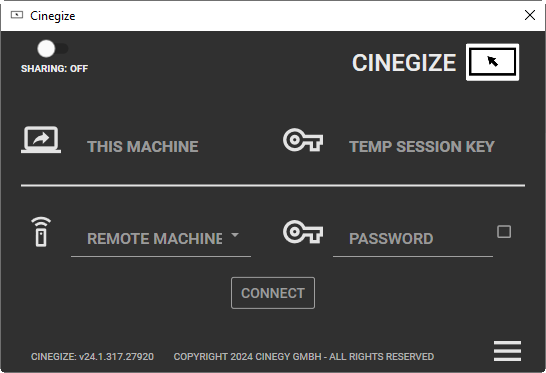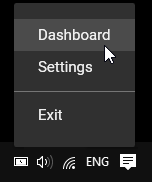Interface
Reading time ~2 minutes
When started for the first time Cinegize looks as follows:

The following controls are available here:
-
Sharing – in the "ON" position this slider is used for working in host mode, while client mode requires the slider to be in the "OFF" position.
NoteSharing is only supported when Cinegize is running in application mode, so it is disabled in service mode. NoteWhen switching from client to host mode, all active connections will be terminated and you will be warned about this by a corresponding message. -
This machine – indicates the name or IP address of the currently operated machine.
-
Temp session key – a randomly generated session key used for access to the currently operated machine.
-
Remote machine – the indication of the remote machine name or IP address, as well as a public alias.
NoteWhen a public alias is used for remote connections, add @to the name (e.g.,cinegy-server@).TipThe drop-down list contains names / IP addresses of the most recently connected clients, with their individual configurations preserved. -
Password – a key to connect to the remote machine in client mode. This can be either a temporary key valid for the current Cinegize session or a long-term key specified for service mode.
|
Press this button to open the Cinegize configurator. |
|
Important
|
Refer to the Settings article for details on how to set up Cinegize. |
System Tray
|
Once Cinegize is launched, the application icon appears in the notification area of the taskbar and remains there, even if the application is minimized to the system tray using the |
Right-click on the system tray icon opens the following menu:

Dashboard
Use the "Dashboard" command to open the "Dashboard" window. When the connection is established, detailed information about the Client and the Host current settings is displayed:

Settings
The "Settings" command navigates to the "Settings" menu when the current settings need to be changed.
Exit
The "Exit" command prompts to close the application with the following confirmation message:


